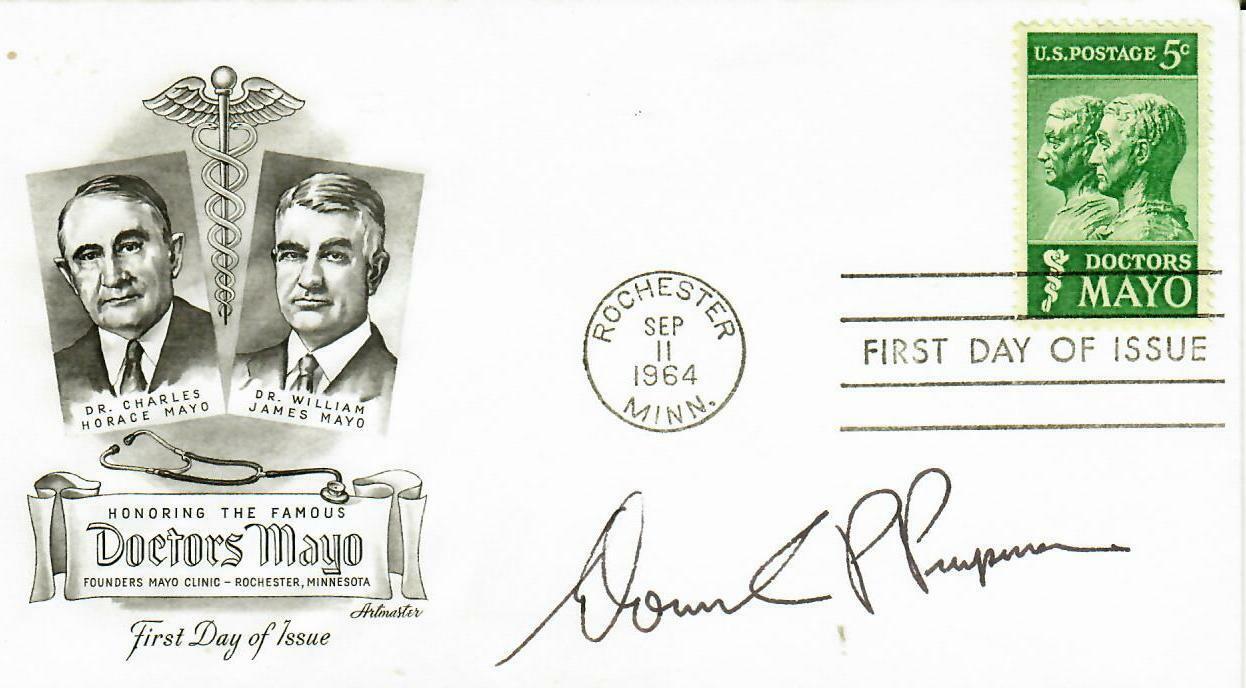"Neuroscientist" Dominick Purpura Hand Signed FDC Dated 1964 For Sale

When you click on links to various merchants on this site and make a purchase, this can result in this site earning a commission. Affiliate programs and affiliations include, but are not limited to, the eBay Partner Network.
"Neuroscientist" Dominick Purpura Hand Signed FDC Dated 1964:
$499.99
Up for sale a VERY RARE! "Neuroscientist" Dominick Purpura Hand Signed First Day Cover Dated 1964.
ES-4079
Dominick P. Purpura (April
2, 1927—May 16, 2019) was a neuroscientist. who was well known for his research
focused on intellectual disability.
His work also focused on the origin of brain waves, developmental neurobiology,
and epilepsy. From 1982 to 1983, Purpura was appointed as the
president of the Society for Neuroscience. In
1984, he was recruited to be the dean of Albert Einstein College of Medicine of Yeshiva University. He
served as the dean for a total of 22 years. Purpura was born in Manhattan, New York on April 2, 1927 and grew up in
the Upper East Side.
After World War II, Purpura
served in the United States Air Force. In
1948, Dr. Purpura married Florence Williams and eventually had four children:
Craig, Kent, Keith, and Allyson.Along with four children, he also
had four grandchildren. In his later years, Purpura resided
in Manhattan, New York with
his wife. On May 16, 2019, he passed away at the age of 92. In 1949, Dominick
P. Purpura earned his Bachelor's degree from Columbia University. He graduated
magna cum laude from Harvard Medical School with a Medical degree. Purpura went
on to teach at Columbia University Vagelos College of Physicians and Surgeons before
being recruited to teach and be the chair of anatomy at the Albert
Einstein College of Medicine of Yeshiva University in 1967. He left Einstein in 1982 to be the
dean of the Stanford
University School of Medicine, however he went back to the Albert Einstein
College of Medicine in 1984 where he remained for the rest of his career After
being recruited in 1967, Purpura served as the Scientific Director of the
Einstein’s Rose F. Kennedy Center for Mental Retardation and Developmental
Disabilities from 1969-1972. The center focused on both
developmental and intellectual disabilities, which were also the focus of
Purpura's research. After two years as the scientific director, he was
appointed as the center's director. In 1974, he founded the neuroscience department
at the university. For a brief moment, Purpura was the dean of Stanford's
School of Medicine but his heart belonged to Albert Einstein College of
Medicine of Yeshiva University. By 1984, Purpura achieved the status of dean of
the university. Purpura is duly recognized as "the longest-serving dean of
any medical school in the United States" after serving a total
of 22 years at Einstein. Due to this long term served, Purpura was able to
accomplish many things throughout his career. During his time as Dean, Purpura
was quoted as positioning Einstein as the "educational hub" of
the five major teaching hospitals in New York : Monteflore Medical Center, Bronx-Lebanon Hospital
Center, Jacobi Medical Center, North Shore-Long Island Jewish Health System, Beth Israel Medical Center.
Since his retirement in 2006, the neuroscience department at the College of
Medicine has been named after him as a way to recognize both his leadership at
the university and in the field of neuroscience. Throughout Purpura's
professional and academic career he published over 200 scientific articles and
chapters. In 1982, Purpura was appointed as the president for the Society of
Neuroscience for a one year term. During his time as president, Dominick
Purpura oversaw the Long-Range Planning Report which helped define the
structure, policies, and programs of the Society. The Report resulted in a
much more well-rounded society that focused on education and increasing the
diversity of the Society. Dominick Purpura's research centered on intellectual
disability, developmental neurobiology, brain waves, and epilepsy. In 2009,
Purpura along with colleague Mark F. Mehler researched the relationship between
an unregulated noradrenergic system during development and Autism Spectrum Disorders. The
noradrenergic receptors are involved with stress response, learning, memory and
more. Their hypothesis resulted in further research in the field in an attempt
to discover ways to target this system in order to help those with autistic
disorders. Purpura also researched the relationship between brain wave activity
and temperature using golden hamsters. His research in this area resulted in
the discovery that hamsters show no brain waves below a bodily temperature of
19 degrees celsius. This discovery lead to investigation of the connection
between temperature and the activity of the nervous system. Along with a few
other colleagues, Dr. Purpura studied electrical stimulation to the human
cortex. They showed that direct stimulation to the human cortex resulted
in a negative response, then a slow positive response, and a slower negative
response. This study lead to further investigation of possible surgeries to
help those with epilepsy.

Related Items:
"Neuroscientist" Dominick Purpura Hand Signed FDC Dated 1964
$349.99

